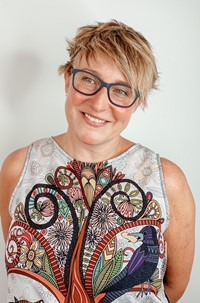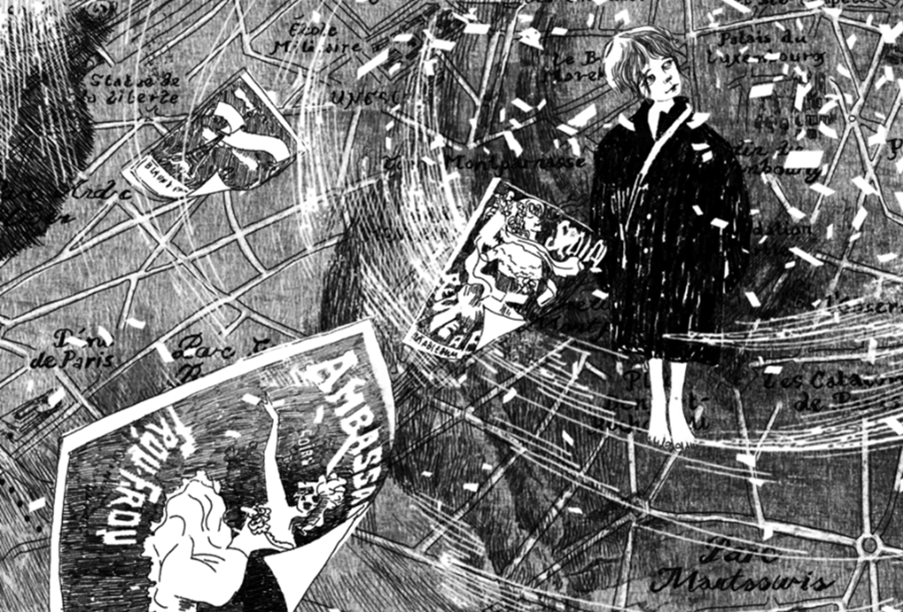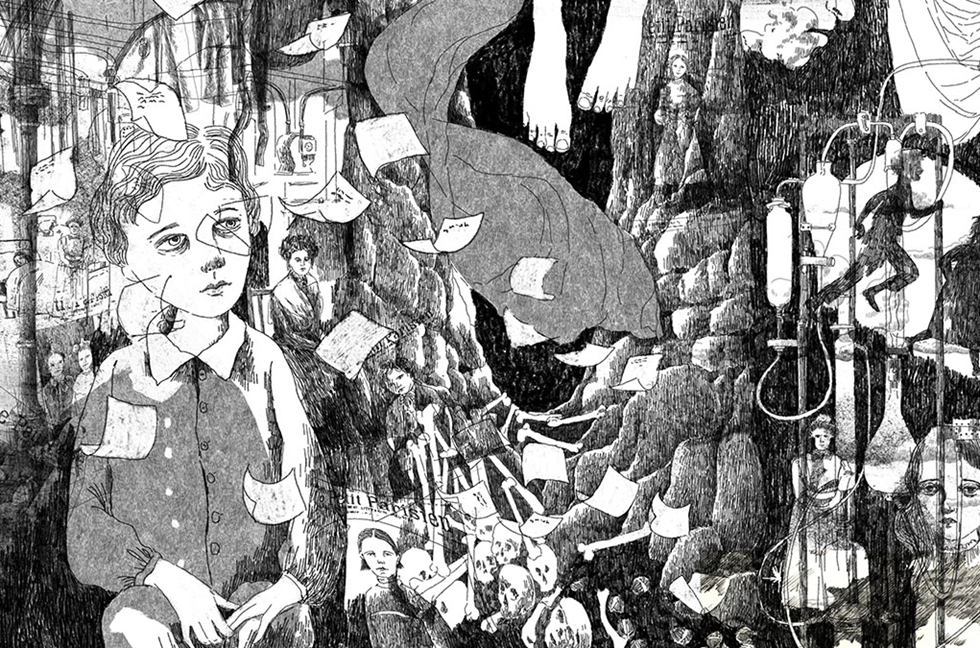Eve McDonnell


About Author
Eve is a children's author and artist who lives in the wilds of Co Wexford with her husband, twins, a dog and three cats. She studied at the NCAD in Dublin before embarking on a career in graphic design and brand development and then decided to write. Eve's debut novel for children, Elsetime, was published in 2020 by Everything With Words and she was awarded literary bursaries by the Arts Council of Ireland for both her second novel, The Chestnut Roaster and her current work in progress, The Last Boy.
As well as writing, Eve provides creative writing and crafting events and is produces the annual WonderFest Children's Book Festival. You can find her on Twitter @Eve_Mc_Donnell, with more on her website at www.evemcdonnell.com.
Interview
The Chestnut Roaster (Everything With Words)
November 2022
Read Chapter One - The Chestnut Roaster
The Chestnut Roaster takes us back in time to the streets of Paris where we meet two young chestnut roasters - a girl, and her brother. While the girl, Piaf, remembers everything, her brother has lost all his life memories. When their community also lose their entire memory of the last year, Piaf is determined to find out who is the memory thief and this takes the reader on an extraordinary adventure beneath the streets of Paris... Author Eve McDonnell tells us more!
Q&A with Eve McDonnell
1. Can you tell us a little about your life as an author? Do you do other kinds of work, too?
Becoming a writer opened many doors for me and shaped both my career and life in so many ways. I primarily consider myself a writer, but the act of writing only takes up a small portion of my time. It does, however, link wonderfully to (and is inspired by) my work as an artist, creative writing teacher, graphic designer, festival producer, wonderlarker and mom to twins. I wear a lot of hats, happily!
2. Why do you enjoy setting your stories, like your debut Elsetime, in the past?
To me, there is something pure and unfiltered about the past. When I place myself in, say for example, the 1800s, smells seem sharper, noises are clearly identifiable, tastes are distinguishable. There is less muddle, the clock ticks more slowly. It is void of static, of plastic and technology and confusion, there is less chance of being overwhelmed. Against such a palette of simplicity, stories can stand out.
3. What inspired your new book, The Chestnut Roaster, about a girl with an extraordinary memory?
My son has a remarkable memory. When he was very small, he would recall the colour of the car parked next to us last week at Tesco, or tell me when I last wore a certain item of clothing. I was intrigued, and when I researched the power of memory, I discovered a condition called hyperthymesia - the ability to recall life's events in the greatest of detail. It is a super-rare ability, and though it might seem like a super-power, it is also a super-burden to those who have it. Memories are triggered easily, luring the person into their past and making it difficult to focus on the present. I imagined it more as the inability to forget rather than the ability to remember, and a character was born.

4. Given her incredible memory, what were the challenges in writing Piaf's story?
Piaf's memories are impatient and attention seeking - if she sees a cat, every cat memory rattles and shouts to be heard, each desperate to tell their tale once again. As her adventures progressed, I realised the story could be easily dominated by her relentless memories - effectively her back story.
Back story is always a tricky thing to balance, often times slowing down pace if overdone or if used in the wrong place. Piaf's memories would persistently rattle for attention in the face of peril or great excitement - precisely where I intended the pace to rise. It was tricky keeping the story and pace moving forward when her memories fought to drag it all back!
5. Who are your favourite supporting characters, and why?
Luc, Piaf's twin brother, is a favourite. In contrast to Piaf's hyperthymesia, Luc has lost all his life's memories - each day he awakes, he has forgotten the previous day and reads a crumpled list of twenty things to understand who and where he is. Every fact he has ever learned is still there in his book-worm head, but he has no recollection of his experiences, his lived life.
Despite this, his personality shines through. He is a perfectionist and does not tolerate grey areas - if someone is wrong, he will correct them, even if that translates as rude. He has sensory challenges and fights hard to control his emotions when things overwhelm, but, underneath the surface, there is a most kind and loving boy who would do anything for his sister.

6. Why did you decide to make Piaf a chestnut roaster and to set the book set in the 1800s - and in Paris?
In addition to being a writer, one of the hats I wear is that of wonderlarker - seeking wonder in the world around me, be it an unusual stone, a peculiar cloud or a strange tree. Chestnuts always fascinated me; I'm no fool - I know what lies inside a spikey burr, but the thrill of opening each and every one echoes the anticipation of opening a surprise gift. I wondered what if something else lay inside. This easily guided my thoughts to chestnut roasting, and not unlike the linked memories in Piaf's mind, my imagination quickly transported me to the bustling streets of Paris where chestnut roasters are commonplace. When I imagined the hug-like smell of roasted chestnuts, I also imagined cobble stones, top hats, horse hoofs. It seemed the perfect stage.
7. How much research did you need to do into the period, and also into Paris of the time?
Research took up a significant amount of time - I was sucked back into the late 1800s happily, having been there for my debut children's book, Elsetime. I found the act of writing following a stint of research to be no different from time travel - my mind truly lived there as I wrote about the sights, smells and sounds. I even imagined the taste of chewy macarons from the original 1880s Ladurée shop! My editor also set me thinking about the attitudes of Parisians as they marked the 100th anniversary of the French Revolution and this sprinkled another layer of history into the story. I have been to Paris many times, but not for some time due to the pandemic. I am returning very soon!
8. Do you have a favourite section in The Chestnut Roaster? Is there a line or two that you'd like to share with our readers?
I think that must be the poem at the beginning of story:
What matters is
Inside, I promise.
Tucked; a seed of life, a shining star,
And the gloss of a giant.
I promise, Inside
Is what matters.
9. Other than a great adventure and mystery story, What would you like your readers to take from The Chestnut Roaster?
I did not write this story to push any moral message - I hope that the reader enjoys it for what it is: a wild adventure of an extraordinary girl in Paris. But I also hope they can connect with how Piaf can overcome her challenges without having to change who she is. On the outside, she might seem small, fragile, flitty and troubled, but inside she is a giant.
10. What do you think of the illustrations by Ewa Beniak-Haremska?
To be honest, they are one of my favourite things in my whole world. The joy I felt on seeing them was so strong it was tangible, and I felt instantly overwhelmed - I had no idea art could be so powerful. They are perfect.
11. Where did you write The Chestnut Roaster, and what is most likely to interrupt your writing day? What is your next book about?
I have a writing room and I have filled it with all of my favourite things - my hagstone collection, my library of children's books, inspirational quotes, art. I have brought nature in - there are leaves and chestnuts, feathers and shells. It is one great big bucket of inspiration.
Any one of the other hats I wear can threaten to interrupt my writing day! I have to be quite disciplined, marking out early hours to do nothing but write. I am currently working on a special book - it was inspired by a very short story I read about a boy with a very short, yet remarkable life. It is set in the 1800s again, this time around the time of The Great Meteor Storm of 1866. I feel the story was written in the stars - I just need to get it written down on paper!
13. What is your favourite way to spend a day when you're not writing?
Early morning wonderlarking on a beach or in a forest, followed by good food with friends and family before reading one of the special children's books I've purposely held off reading while I wait for the perfect time to savour every word...
 The Chestnut Roaster
The Chestnut Roaster
 Elsetime
Elsetime
